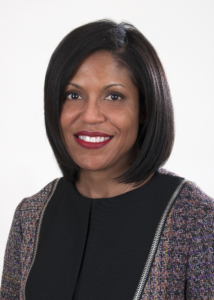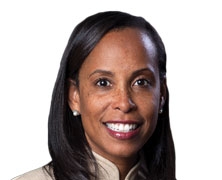 More than 10 years ago, while attending the annual convention of the International Council of Shopping Centers (ICSC), Gina Love realized that few people attending looked like her.
More than 10 years ago, while attending the annual convention of the International Council of Shopping Centers (ICSC), Gina Love realized that few people attending looked like her.
“I literally started counting people of color – especially women of color,” recalls Love, a counsel at global law firm Shearman & Sterling. Of those she met, several were from New York, so Love and her new acquaintances came up with the idea of organizing a get-together of people with diverse backgrounds as a networking opportunity when they returned to convention the following year. Their outreach was decidedly grassroots – emailing people they knew and handing out fliers — so they were stunned that word had spread so fast that they were joined by nearly 200 people.
“We knew we were on to something so I started organizing it as an unofficial event at ICSC every year, securing sponsors, inviting speakers and raising money,” says Love, adding that Shearman & Sterling has been unequivocally supportive over the years. For 11 years, Love kept the event afloat on her own time, which though laborious was extremely rewarding. “It’s amazing to see the room clogged with people, many of them telling me that they come to ICSC’s convention primarily for this event,” she says. Eventually, though, she realized the reception needed to be self-sustaining, and ICSC agreed to officially take it over.
Today, the ICSC’s Diversity Reception is attended by anywhere from 600-850 people and has a long list of impressive financial sponsors and speakers from throughout the real estate industry. At the 2014 event, the ICSC announced the creation two scholarships: the “Retail Real Estate Diversity Scholarship” to offer tuition assistance to graduate students entering the retail and real estate industries; and the “Love Scholarship for Diversity,” named in Love’s honor to offer tuition assistance to sophomore, junior and senior university students belonging to an underrepresented minority group. “The whole thing started so innocently, and it was amazing to watch how it grew,” Love says. “It was really wonderful to see that my decade of work to increase diversity in the real estate industry was honored and appreciated by the leadership of ICSC, and I am delighted the legacy will go on.”
Real Estate Roots
Love chose a career in law because she felt it offered a way for her to showcase her strengths in writing and research. She preferred the business-oriented classes during law school and though she did a rotation in litigation, Love gravitated toward a specialization in real estate. Her family had built a background in various facets of real estate – from her aunt who was a broker and real estate investor to her grandfather who had built a residential development and construction company in Jamaica, W. I. , where she is from – so it was an industry with which she was quite familiar. And she has not been disappointed by her expectations of a career in law. Ever since her initial stint as a summer associate, she viewed the field of law as one with multiple challenges, but also extremely rewarding moments.
Recently, Love experienced one of those moments when she helped close a key phase of a complex international deal she had been working on with her Shearman & Sterling counterparts in Germany, along with Mexican counsel. “There were cultural differences to navigate but we had a solid team and it was very satisfying work,” she says. “That kind of international transaction is a real focus for me and for our firm.”
That is part of the appeal of the real estate specialization for Love – the constant diversity. For example, she is also representing a high-end luxury fashion client that recently received a significant influx of capital and is opening stores around the US.
“One of the reasons I really like real estate is because I feel as though it’s one of the only segments of law where you can see the creative result of your work,” she explains. “Real estate attorneys in New York can walk around this city and see visible, tangible signs of what he or she has accomplished — We aren’t the architects or the developers, but as lawyers, we do a lot of the ‘behind-the-scenes’ work to make it happen. Sometimes law is hard to explain to others, and I find the real estate specialty to be one of the few where you can really show people something you had a hand in creating.”
Mentors Helped Her Succeed
Love knows that mentors and sponsors have had a major impact on her career. At her former firm, Nixon Peabody, she knew of at least four partners in the real estate practice area whom she said were extremely supportive of her career from the beginning. “I would say that they really guided, guarded and watched over my career,” she recalls fondly.
Now, she has mentors both inside and outside Shearman & Sterling. At Shearman & Sterling, she says she has been guided and supported by real estate practice leader Chris Smith, who has been particularly helpful in the areas of networking, developing client relationships and deal work.
She also has an ongoing mentor relationship with a former colleague at Nixon Peabody, Elizabeth Moore, who is now General Counsel at Consolidated Edison. She says, “We were drawn to each other because she also has Caribbean roots, and we just related really well. It’s fascinating to talk with her about the different facets of her career, since she has had so many completely different roles. She was in State government then became a labor and employment law partner before becoming the GC of Con Ed. We talk frequently about how to deal with specific professional situations, but also just in general how life is going. Our relationship has been very valuable.”
A Clear Plan for Growth
When Love reflects on the qualities that have set her up for success, her method is simple but effective. “I set my goals, chart my plan and start working toward it,” she says, noting that it’s imperative to have multiple plans of action to address eventualities that might come up. She says this approach is something she learned from her father, her biggest role model, who worked as a chemical engineer but also earned a business degree. “You have to adjust periodically to what isn’t working anymore and take personal responsibility for what you do.,” she says. “The road might not always be smooth, but you can get there with a clear but flexible plan.”









